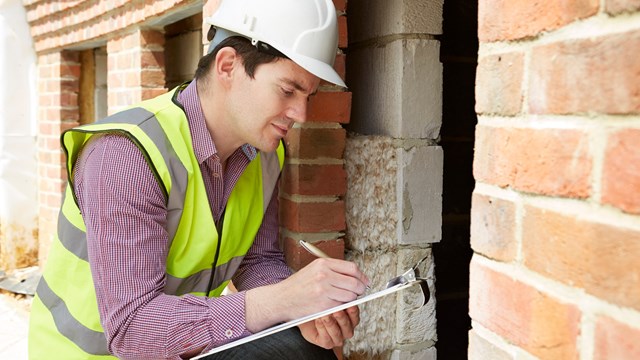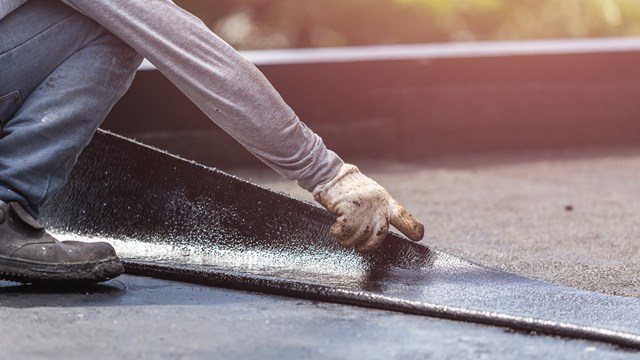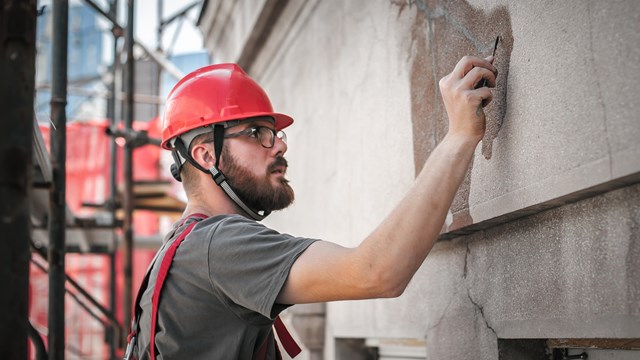The first week of 2015 brought torrential downpours and freezing temperatures to the New England area, and this horrendous wind-driven rain resulted in numerous calls to weatherproofing and waterproofing companies throughout the area from condominiums seeing water creeping into their buildings.
While some condo managers may think that only big storms like Hurricane Sandy can cause damage, truth be told, any rain or ice storm can be a costly problem if the building’s façade is not properly maintained.
Doug Mitchell, director of operations for ESI Waterproofing and Masonry Restoration Inc., in Boston, Massachusetts, has been helping condos with all phases with masonry and waterproofing for dozens of years.
Look Out for Leaks
“If it starts as a wind-driven rain, then freezes and defrosts and it continues through that cycle, what happens is that water gets in between the open joints and cracks them and opens them up even more,” he says. “In New England, the winters are harsh and some of the condominiums do not maintain their buildings as well as they should.”
Paul Capobianco, president at Alpha Weatherproofing in Somerville, Massachusetts, says there are a lot of older and historic buildings in the greater New England area that require update and maintenance. It may be an ongoing leak or problem with water penetration, or it may be just something in someone’s unit that needs inspection.
“We work with condos who are having ongoing problems with leaks around windows, parking garages, etc., like from the rains we recently had,” says Capobianco. “And then there are those communities who are more active and have been putting money aside and know they need to re-caulk the building or fix sealant joints around windows, which can fail after 15 years or so.”
One misconception Mitchell often hears from bricklayers is that water will not penetrate the masonry—but it will, and it’s important that condos understand this.
“The importance of waterproofing and installing the proper flashing is crucial to stopping the water from infiltrating into the building,” he says. “A lot of times we get calls because there is water infiltrating through the windows and we do a water-test investigation. Often we find out that the flashing has failed, so we remove the brick, waterproof the membrane behind the brick and install end-dams and then reinstall the brick with weepers and that usually takes care of it.”
Weatherproofing and waterproofing need to be done for more than just masonry buildings. Mitchell says anything to do with the outside façade and the materials used, can cause problems.
For example, buildings that are made from concrete block can suffer from mold infestation when water issues come up. In these condos, it’s important to properly seal the split face blocks.
“Some New England condos use the aluminum panels with caulk in between them, and you need to look at the cracks within them as well,” Mitchell says. “It’s an all full-metal-jacket approach.”
Bill Sylvester, vice president at CCI Building Restoration & Waterproofing, located in North Hampton, New Hampshire, says his company is contacted usually when the condominium first sees some water coming in.
“We visually inspect everything with binoculars, and being experienced, we know what to look for on the concrete or brick work or block work,” he says. “You look at all the mortar joints, look for cracks, look at caulking around windows, and find what the problem is so we can resolve it.”
When to Act
One problem with weatherproofing a building is that because of budgetary concerns and a feeling of safety when everything is operating smoothly, most condominiums will wait until there’s a problem to do something about it.
“Most of the time it’s the result of something happening,” Mitchell says. “If there are changes to the building—add-ons, installation of new windows—it should be done at these times.”
A solid inspection includes the roof, parapet wall and flashings and all the flashings above all windows and doors, caulking around the windows and doors, decks and through wall protrusions.
The cost to weatherproof a building varies depending on how easy the access is, the time of year the work is done (spring is a good time to check in!), the scaffolding required and how old the facade is.
Alpha Weatherproofing recently did a job for Crown Pointe Condominiums in Swampscott, Massachusetts, in which failed flashing and structural problems had created leaks that allowed water to penetrate and compromise its deck structure.
Its solution was to use the solvent-free, cold liquid-applied waterproofing system Kemperol 2K PUR, catalyzed urethane with reinforcing fabric, which was used to reconstruct the flashing and waterproof the total deck area. Through-wall flashing and masonry was then installed, along with an updated railing system.
“It was an outdoor patio over a garage and they were having ongoing leaking into those areas and also outside the building’s meeting facility room, so people would go outside on the terrace, so it needed to use a material that would withstand the foot traffic,” Capobianco says. “The Kemper System is a very durable system and can be done with lots of colors and finishes to make it attractive so it doesn’t look like it’s just a black leather roofing.”
Another project saw the Watermill Place Condominiums in Arlington, Massachusetts, in need of an update to its upper level carport, which Capobianco says was originally waterproofed with a single-ply membrane that had failed. It was allowing water to penetrate down through the topping slab and precast plank system onto cars parked on the lower level.
Capobianco says his company utilized reinforced plastic placed under the slab to prevent leaking or further damage to cars. A special protection course/drainage mat was installed and a 1.5-inch macro fiber reinforcement was added to concrete to prevent cracking.
Material Matters
Below-grade waterproofing systems are critical for the protection of subterranean portions of any building or structure.
According to the weatherproofing experts, there have been lots of changes in materials over the years. Today, several systems are available, ranging from crystalline waterproofing systems, to hot rubberized asphalt applications, to sheet membrane systems that are heat-welded together.
“The manufacturers have changed the chemical compositions of them and made them more durable, so you’re getting better longevity,” Capobianco says. “It’s a tough environment here in New England and things go through some extreme cycles temperature-wise, so a lot of the chemistry is improved to make it withstand that better.”
Mitchell says new things are coming to market all the time and ESI tries to be on the cutting edge of what’s coming out next.
“When I was first laying brick, PVC flashing was the most cost-effective and what they thought was a fail-proof flashing—but now that 20 years have gone by, we’re finding when we open the walls that it just dries up and breaks off the wall, so it’s not as good as what we thought,” he says. “There have been a lot of asphalt membrane flashings that have come up on the market and a liquid membrane itself, so it’s evolving all the time.”
When working a job, weatherproofing companies normally will start with the facade and utilize protection boards, drainage boards and insulation. In areas where ground water pressure is of concern, bentonite panels are often placed below the slab on grade as opposed to a conventional vapor barrier.
CCI recently worked on the Wellington Condos in Medford, Massachusetts, and Sylvester says the brick building and its concrete towers were both attracting water. To fix the problem, he used waterproofing on the towers and sealed the cracks in the brick.
Insurance and Safety Issues
Nicole Guzzardi, senior communications specialist for The Travelers Companies in Hartford, Connecticut, says protecting against water and weather issues is an important part of a condo’s risk assessment when it comes to insurance.
“One significant source of water damage to property can come from weather-related moisture or flooding, including: flooding from heavy rains, flash floods, dam and levee failures, tidal storm surges and mudflows,” she says. “Common causes of water damage include leaky baseboard heating, air conditioning condensation drains, water heaters, washing machine hoses and plumbing.”
No condominium or community association wants to deal with water or weather issues damaging its building, which is why that in addition to getting inspections, there are some warning signs that maintenance staff can be on the lookout for to stop the freeze-and-thaw cycle that can cause major damage.
“Because the economy was so bad, no one could do all four facades of their waterproofing so we would come in and do either one whole elevation or sections of elevation; the key element is to continue doing that,” Mitchell says. “What they should be doing is hiring someone who can do due diligence and review the outside of the building to ensure the sealants are in place, nothing has failed and there are no cracks in the masonry. It’s key to catch any of this before moisture or anything else can infiltrate through the open areas.”
Capobianco feels a savvy condo management company will have an engineer or consultant to inspect the property.
“It’s smart to hire a company that does building envelope work to come out and do periodic inspections every three to five years and evaluate things, and give the management company recommendations of stuff that should be addressed in the future,” he says. “A good assessment can help create a timeline of what needs to be done right away, what is five years away, and what is 10 years away.”
Waterproofing systems can make or break any facility’s structural integrity, so it’s important to stay on top of maintenance issues and help your condo stand the test of time.
Keith Loria is a freelance writer and a frequent contributor to New England Condominium.










Leave a Comment